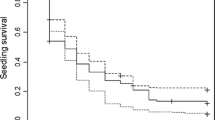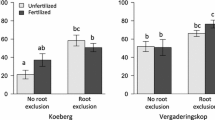Abstract
A top priority in the field of invasion ecology is to investigate the mechanisms that lead to the successful establishment and spread of harmful exotic species. Studying plant invasions in the context of the invaded community can help us to understand those mechanisms. In this study, we follow a community approach where we describe establishment and growth patterns of an exotic shrub, Elaeagnus umbellata, with respect to the local woody plant community. Primarily focusing on a forest ecosystem, we expect light availability to be a driving factor in the recruitment of E. umbellata individuals; however, this is not supported for seedling recruitment as light becomes detrimental to survival in conditions exceeding 30 % full sun. Instead, growth of first year seedlings is primarily affected by soil moisture. Forest census data of adult individuals show that growth of E. umbellata is affected by light and small-scale neighborhood density (i.e., limited in the understory by space or resources), suggesting a shift in resource requirement. Overall, our study indicates that although E. umbellata individuals are likely to recruit and persist in the understory, successful growth to adulthood is controlled by competitive interactions.



Similar content being viewed by others
References
Adams TP, Purves DW, Pacala SW (2007) Understanding height-structured competition in forests: is there an R* for light? Proc R Soc B 274:3039–3048
Ahmad SD, Sabir SM, Zubair M (2006) Ecotypes diversity in autumn olive (Elaeagnus umbellata Thunb.), a single plant with multiple micronutrient genes. Chem Ecol 22(6):509–521
Allen D, Vandermeer J, Perfecto I (2009) When are habitat patches really islands? For Ecol Manag 258:2033–2036
Anderson MC (1964) Light relations of terrestrial plant communities and their measurement. Biol Rev 39:425–486
Barnes BV, Wagner WH (2004) Michigan trees: a guide to the trees of the Great Lakes region (revised and edited). University of Michigan Press, Ann Arbor
Bazzaz FA (1979) The physiological ecology of plant succession. Annu Rev Ecol Syst 10:351–371
Black BL, Fordham IM, Perkins-Veazie P (2005) Autumnberry (Elaeagnus umbellata): a potential cash crop. J Am Pomol Soc 59(3):125–134
Brym ZT, Lake JK, Allen D, Ostling A (2011) Plant functional traits suggest novel ecological strategy for an invasive shrub in an understory woody plant community. J Appl Ecol 48:1098–1106
Callaway RM, Schaffner U, Thelen GC, Khamraev A et al (2012) Impact of Acroptilon repens on co-occurring native plants is greater in the invader’s non-native range. Biol Invasions 14(6):1143–1155
Catling PM, Oldham MJ, Sutherland DA, Brownell VR, Larson BMH (1997) The recent spread of Autumn-olive, Elaeagnus umbellata, into Southern Ontario and its current status. Can Field Nat 111(3):376–380
Clark JS (2005) Why environmental scientists are becoming Bayesians. Ecol Lett 8:2–4
Congdon P (2003) Applied Bayesian modelling. Wiley, West Sussex
Cox D (1972) Regression models and life-tables (with discussion). J R Stat Soc B 34:187–220
Diez JM, Williams PA, Randall RP, Sullivan JJ et al (2009) Learning from failures: testing broad taxonomic hypotheses about plant naturalization. Ecol Lett 12:1174–1183
Ebinger JE (1983) A potential problem in natural areas management in Illinois. Nat Area J 3:3–6
EDDMapS (2014) Early detection and distribution mapping system. University of Georgia. http://www.eddmaps.org/. Last accessed 11 Mar 2014
Edgin B, Ebinger JE (2001) Control of autumn olive (Elaeagnus umbellata Thunb.) at Beall Woods Nature Preserve, Illinois, USA. Nat Area J 21(4):386–388
Engberg CA, Austin FR (1974) Soil Survey of Livingston County, Michigan. USDA Soil Conservation Service. http://www.nrcs.usda.gov/wps/portal/nrcs/surveylist/soils/survey/state/?stateId=MI
Enquist BJ, Brown JH, West GB (1998) Allometric scaling of plant energetics and population density. Nature 395:163–165
Fargione JE, Tilman D (2005) Diversity decreases invasion via both sampling and complementarity effects. Ecol Lett 8:604–611
Gabler CA, Siemann E (2012) Environmental variability and ontogenetic niche shifts in exotic plants may govern reinvasion pressure in restorations of invaded ecosystems. Rest Ecol 20(5):545–550
Gelman A, Carlin JB, Stern HS, Rubin DB (1995) Bayesian data analysis. Chapman and Hall, London
Greiling D (2000) Detailed ESGR soils map. University of Michigan Museum of Zoology and E.S. George Reserve. http://www-personal.umich.edu/~sarhaus/courses/NRE530_F1999/04dunrie/detsoils.html
Hunt R (1982) Plant growth curves. The functional approach to plant growth analysis. Edward Arnold, London
Ibáñez I, Schupp EW (2001) Positive and negative interactions between environmental conditions affecting Cercocarpus ledifolius seedling survival. Oecologia 129(4):543–550
Johnstone IM (1986) Plant invasion windows: a time-based classification of invasion potential. Biol Rev 61:369–394
Jonsen KH, Bongarten BC (1992) Relationships between nitrogen-fixation and growth in Robina pseudoacacia seedlings—a functional growth analysis approach using N-15. Physiol Plant 85(1):77–84
Keddy P (1992) Assembly and response rules: two goals for predictive community ecology. J Veg Sci 3(2):157–164
Kennedy PG, Hausmann NJ, Wenk EH, Dawson TE (2004) The importance of seed reserves for seedling performance: an integrated approach using morphological, physiological, and stable isotope techniques. Oecologia 141:547–554
LaFleur NE, Rubega MA, Elphick CS (2007) Invasive fruits, novel foods, and choice: an investigation of European starling and American robin frugivory. Wilson J Ornithol 119(3):429–438
Levine JM, Adler PB, Yelenik SG (2004) A meta-analysis of biotic resistance to exotic plant invasions. Ecol Lett 7:975–989
Lunn D, Spiegelhalter D, Thomas A, Best N (2009) The BUGS project: evolution, critique, and future directions. Stat Med 28:3049–3067
Maroco JP, Rodrigues ML, Lopes C, Chaves MM (2002) Limitations to leaf photosynthesis in field-grown grapevine under drought—metabolic and modelling approaches. Funct Plant Biol 29(4):451–459
Martin PH, Marks PL (2006) Intact forests provide only weak resistance to a shade-tolerant invasive Norway Maples (Acer platanoides L.). J Ecol 94:1070–1079
McCarthy-Neumann S, Ibáñez I (2012) Tree range expansion may be enhanced by escape from negative plant–soil feedbacks. Ecology 93(12):2637–2649
Mwangi PN, Schmitz M, Scherber C, Roscher C et al (2007) Niche pre-emption increases with species richness in experimental plant communities. J Ecol 95:65–78
Naeem S, Knops JMH, Tilman D, Howe KM et al (2000) Plant diversity increases resistance to invasion in the absence of covarying extrinsic factors. Oikos 91(1):97–108
Orr SP, Rudgers JA, Clay K (2005) Invasive plants can inhibit native tree seedlings: testing allelopathic mechanisms. Plant Ecol 181:153–165
Pashke MW, Dawson JO, David MB (1989) Soil nitrogen mineralization in plantation of Juglans nigra interplanted with actinhorhizal Elaeagnus umbellata or Alnus glutinosa. Plant Soil 118:33–42
Pimentel D, Lach L, Zuniga R, Morrison D (2000) Environmental and economic costs of nonindigenous species in the United States. Bioscience 50(1):53–65
Pokorny ML, Sheley RL, Zabinski CA, Engel RE et al (2005) Plant functional group diversity as a mechanism for invasion resistance. Restor Ecol 13(3):448–459
Preston DL, Henderson JS, Johnson PTJ (2012) Community ecology of invasions: direct and indirect effects of multiple invasive species on aquatic communities. Ecology 93(6):1254–1261
Pyšek P, Richardson DM (2007) Ecological Studies, chap 7: traits associated with invasiveness in alien plants: where do we stand?, vol 193. Springer, Berlin
Rejmánek M, Richardson DM (1996) What attributes make some plant species more invasive? Ecology 77:1655–1661
Richardson DM, Bond WJ (1991) Determinants of plant distribution: evidence from pine invasion. Am Nat 137(5):639–668
Sakai AK, Allendorf FW, Holt JS, Lodge DM et al (2001) The population biology of invasive species. Annu Rev Ecol Syst 32:305–332
Severtson EM. (2005) Monitoring an exotic species invasion using high resolution remote sensing. Master’s Thesis, University of Michigan, School of Natural Resources
Shea K, Chesson P (2002) Community ecology theory as a framework for biological invasions. Trends Ecol Evol 17:170–176
Theoharides KA, Dukes JS (2007) Plant invasion across space and time: factors affecting nonindigenous species success during four stages of invasion. New Phytol 176:256–273
Vitousek PM, Dantonio CM, Loope LL, Westbrooks R (1996) Biological invasions as global environmental change. Am Sci 84(5):468–478
Yates ED, Levia DF, Williams CL (2004) Recruitment of three non-native invasive plants into a fragmented forest in southern Illinois. For Ecol Manag 190:119–130
Acknowledgments
A number of individuals have contributed constructive criticism and guidance throughout the writing of this manuscript. Thank you to the D.O. et al., D. R. Zak, J. Lake, A. Ostling, E. Werner, and C. Davis. Funding for the forest census came from a USDA McIntire-Stennis Grant.
Author information
Authors and Affiliations
Corresponding author
Electronic supplementary material
Below is the link to the electronic supplementary material.
Rights and permissions
About this article
Cite this article
Brym, Z.T., Allen, D. & Ibáñez, I. Community control on growth and survival of an exotic shrub. Biol Invasions 16, 2529–2541 (2014). https://doi.org/10.1007/s10530-014-0683-4
Received:
Accepted:
Published:
Issue Date:
DOI: https://doi.org/10.1007/s10530-014-0683-4




